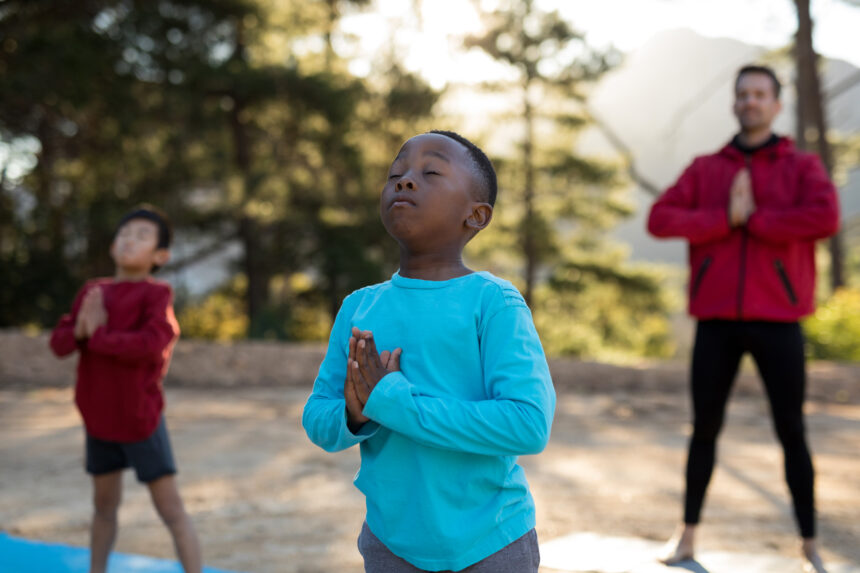In the journey of life, our children face a multitude of challenges that can sometimes leave them feeling overwhelmed and stressed. As parents, we can introduce them to a time-tested practice that helps combat stress and promotes mental well-being: meditation.
Meditation is a technique that involves training the mind to focus on the present moment, acknowledging and accepting any thoughts or feelings that arise. It’s a practice that has been utilised for centuries across different cultures and religions to foster relaxation and spiritual growth.
One of the key benefits of meditation is its ability to help children think more deeply and focus on what they want from their lives. By quieting the mind, they can tap into their inner selves, gaining clarity on their goals and aspirations. This in turn equips them to make better decisions, cultivate positive emotions, and lead a more fulfilling life.
Meditation has been scientifically demonstrated to have numerous health benefits. Studies have shown that regular meditation can enhance brain function, reduce stress and anxiety, promote better sleep, and even lower blood pressure.
The practice of meditation can be a potent tool for fostering inner peace, promoting mental and physical well-being in your child. Whether your child is a beginner or an experienced meditator, incorporating this practice into their routine can lead to a more balanced and fulfilling life.
How meditation can enhance your child’s life
Regular practice of meditation can profoundly impact your child’s overall well-being. From reducing stress to boosting creativity, the benefits of meditation are numerous. Indeed, studies have shown that young people who meditate regularly enjoy a range of physical and mental benefits.
Firstly, meditation has been shown to mitigate stress and anxiety. When your child meditates, they give themselves a chance to break from the chaos of daily life, alleviating feelings of overwhelm and tension. In addition, meditation has been found to reduce symptoms of depression and improve overall mood, as it promotes the production of feel-good hormones like serotonin.
But the benefits of meditation aren’t just limited to mental health. Regular practice has also been shown to positively affect physical health. For instance, meditation can help lower blood pressure and improve cardiovascular function. It can also enhance the immune system, making your child less prone to illness.
Meditation has been found to boost creativity and improve focus. It can sharpen the mind and augment cognitive function, making it easier to break through mental blocks and generate new and innovative ideas.
Tips for establishing a successful meditation practice for your child
Establishing a regular practice can be challenging, especially when life gets busy. Here are some tips to help you initiate your child with meditation and make it a regular part of their routine.
1: Begin with bite-sized chunks
If your child is new to meditation, it’s best to start with just a few minutes each day. You can gradually increase the time as they become more comfortable with the practice. Starting small can help your child overcome any resistance they may have to starting a new habit. Even five minutes of meditation each day can have a significant impact on their wellbeing.
2: Set a daily reminder
Setting a reminder on your phone or calendar for your child to meditate each day can help establish a consistent routine, ensuring that they make time for this practice even on busy days. Trying to meditate at the same time each day can make it easier to remember.
3: Ensure a comfortable position
When meditating, it’s important for your child to find a comfortable position that they can maintain for several minutes. This can be sitting cross-legged on the floor, sitting in a chair, or lying down. Experiment with different positions until you find one that works best for your child.
4: Handling distractions
Distractions are a natural part of the meditation process. Your child’s mind may wander, or they may become distracted by external noises. Instead of getting frustrated, encourage them to accept these distractions and gently guide their attention back to their breath or mantra. It takes practice to be able to focus for long periods, so don’t be discouraged if they find it difficult at first.
5: Setting attainable goals
Lastly, setting attainable goals can help your child establish a successful meditation practice. This might mean committing to meditating for a certain amount of time each day, or aiming to meditate for a specific number of consecutive days. Remember, meditation is a journey, not a destination. Be patient with your child, and let them enjoy the process.
Exploring various meditation techniques for your child
Mindfulness meditation is the practice of being present in the moment and focusing on your breath. This meditation technique encourages acceptance and non-judgmental thoughts, which is helpful for managing stress and anxiety. By focusing on the present moment, mindfulness meditation helps children develop a greater awareness of their thoughts, feelings, and surroundings.
Zen meditation is a form of meditation that originated in Japan. It involves sitting in a specific posture and breathing in a particular way to achieve a state of heightened awareness. Zen meditation focuses on the breath and how it flows through the body, which helps calm the mind and relax the body.
Guided meditations are led by a teacher or an audio recording that guides individuals through various techniques, including visualisation, deep breathing, and body scans. These types of meditations are excellent for children who may find it challenging to quiet their minds during meditation.
Transcendental meditation is a mantra-based meditation practice that involves silently repeating a specific sound or word. This technique helps children achieve a deep state of relaxation and reduces stress and anxiety.
Loving-kindness meditation is a type of meditation practice that focuses on developing feelings of compassion, empathy, and love towards oneself and others. This technique involves sending positive thoughts and energy to different people, including oneself, family, friends, and even strangers.
Creating an ideal meditation space for your child: tips and recommendations
If your child has been practising meditation for a while or just starting out, it’s crucial to find the right environment for their practice. A comfortable and inviting environment can greatly enhance your child’s meditation practice by helping them achieve a deeper sense of relaxation and concentration.
Here are some recommendations for creating the perfect meditation space:
Choose a quiet and comfortable space: Find a secluded spot in your home where your child can sit comfortably without any disturbance. It can be a cosy corner in their bedroom or a quiet space in your garden.
Use comfortable seating: Invest in comfortable seating that supports their back and allows them to sit up straight without any discomfort. This could be a meditation cushion, yoga mat or a comfortable chair.
Set the mood with aromatherapy: Use scented candles or incense to create a relaxing and calming atmosphere. Essential oils like lavender, peppermint, and frankincense are great for relaxation and concentration.
Play soft music: Soft music can be soothing and help your child relax during their meditation practice. Choose relaxing and calming music, preferably without lyrics or vocals.
Maintain a clean and clutter-free space: Meditation is about decluttering the mind, so it’s essential to maintain a clean and clutter-free environment. Keep your child’s meditation space tidy and organised.
Guiding your child towards a mindful lifestyle: incorporating mindfulness into every moment
As our children navigate through the fast-paced modern world, it’s easy for them to get caught up in the hustle and bustle of daily life. They might find themselves constantly reaching for their smartphones or turning to other distractions to avoid being fully present in the moment. However, by incorporating mindfulness into their daily routines, they can learn to live more purposefully, move with intention, and fully appreciateRemember, meditation is a journey. So, start slow, be patient with yourself, and enjoy the process. Happy meditating!
Final Thoughts
In our fast-paced and ever-changing world, it’s essential to equip our children with tools that promote resilience, calm, and focus. Meditation is a potent tool that can serve as an anchor amidst life’s constant swirl of activity.
Teaching your child to meditate not only offers them a respite from their daily stressors but also helps them build emotional intelligence and resilience. It gives them the ability to harness their thoughts and emotions, enabling them to navigate through life’s ups and downs with greater ease and grace.
So, as we strive to guide our children towards a path of tranquillity, let us remember the role that mindfulness and meditation can play in this journey. It’s not just about calming their minds for a few minutes each day; it’s about empowering them with a lifelong skill that fosters emotional well-being, enhances cognitive function, and ultimately, enables them to lead fulfilling and balanced lives.
Remember, meditation is a journey and not a destination. It requires patience, consistency, and a gentle approach. The fruits of this practice might not be visible immediately, but over time, they will surely be profound.

The Abundance Mentor


Leave a Reply